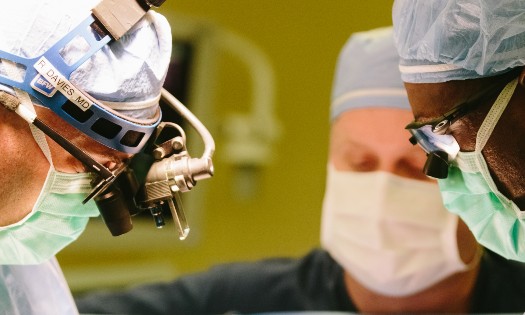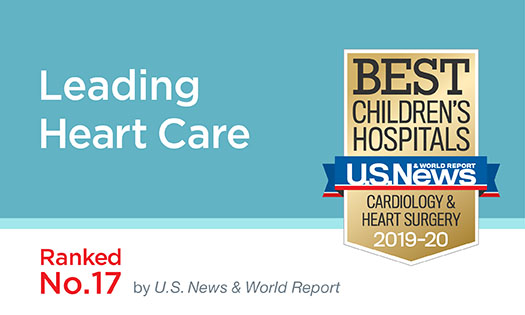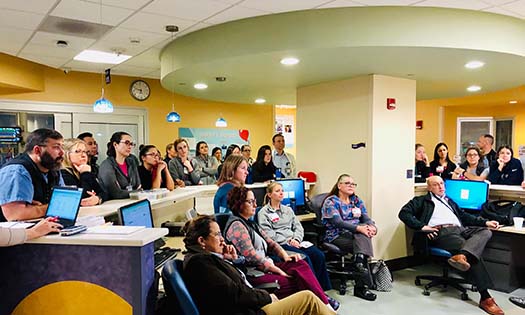The innovation: New technology informs surgical planning for improved outcomes
Experts at Children’s Medical Center Dallas, part of Children’s Health℠, and UT Southwestern are developing the next generation in 3D heart models. Whereas standard anatomical models provide 3D representations of a heart before surgery, the new iteration uses physiological data to show how a heart will function after surgery.
“That foresight is critical for complex cases that require radical changes to circulation,” says Nicholas Andersen, M.D., Pediatric Cardiothoracic Surgeon at Children’s Health and Associate Professor at UT Southwestern. Dr. Andersen co-leads the team developing the new technology, along with Tarique Hussain, M.D., Pediatric Cardiologist at Children’s Health and Professor at UT Southwestern.
With standard 3D models, surgeons don’t know whether a planned procedure will work until afterward, when the child’s life depends on it. Physiological modeling gives surgeons a window into the future so they can choose the most appropriate surgery for each child.
“Our goal is to understand each heart on a case-by-case basis. Physiological models add to the other tools we need to do this work safely and provide the best plans and outcomes for our patients,” says Dr. Andersen.
Why it matters: Physiological models inform surgical approach
Traditional 3D models help heart surgeons plan procedures by showing them more features in more detail than they can get from 2D images. Dr. Andersen calls this “anatomical modeling,” because it captures fine details of the heart’s anatomy. But even these models don’t show you everything.
“How will the heart look after surgery? Will it pump effectively? Will the valves leak? These are things you need to know before you operate,” says Dr. Andersen.
One example is complex biventricular repair. The surgery takes a child’s ventricles from working together to working separately, and there’s no guarantee they will be up for the job.
“With physiological modeling, I can see how the ventricles will perform and make an informed decision about the best path forward for the child,” Dr. Andersen says.
What to know: Creating and using physiological models
Physiological models depict the heart’s future state by combining data from cardiac imaging and a patient’s physiological data, including:
Anatomical images from echocardiograms and CT scans
Physiological data from cardiac MRIs
Electrical information from ECG readings
Hemodynamic data including invasive pressure measurements
Drawing on a range of inputs makes the models extremely detailed and personalized – a comprehensive forecast for each heart.
“It also reduces error, because the model doesn’t depend on any one factor too much,” says Dr. Hussain.
Assembling all this data and translating it into dynamic 3D images takes a large team and a lot of iteration: experts who capture the images and readings, experts who interpret the images – distinguishing anatomy from shadows, for example – and experts who make the final 3D renderings.
“Dr. Andersen gives us feedback along the way, telling us what needs to improve so he can see everything he needs to see,” Dr. Hussain says.
Putting it into practice: Which cases call for physiological models?
Dr. Andersen and Dr. Hussain use physiological models for surgeries that dramatically change the physiology of the heart, including:
Complex biventricular repair or conversion
Valve repair following repaired Tetralogy of Fallot (ToF). A physiological model helps surgeons assess the need for valve repair with greater precision than cardiac catheterization.
The Double Switch Operation (DSO) for congenitally corrected transposition of the great arteries (CCTGA). A physiological model can predict whether the DSO will be successful – and if the left ventricle can pump blood to the body with enough strength.
Patient example: Physiological models prevent potentially grave outcomes
Dr. Andersen and Dr. Hussain recently collaborated on a physiological model to plan surgery for a girl, age 9, with CCTGA.
The model showed signs that a DSO could lead to failure in the left ventricle. So they decided on a different approach, leaving the ventricles in the switched position but fixing all other defects in the child’s heart.
“Without physiological models, you don’t see risks like these until surgery is done and the child needs a transplant to stay alive,” says Dr. Andersen.
What’s next: Improving 3D modeling at Children’s Health and beyond
Children’s Health and UT Southwestern are national leaders in pioneering innovations in pediatric cardiology and cardiothoracic surgery. Dr. Andersen’s and Dr. Hussain’s work to improve surgical planning and outcomes also includes early adoption of virtual reality and myocardial modeling.
Physiological modeling is still new, and they’re working on improving the process with AI and automation that help scan patients and construct images faster.
“We’re also sharing this approach and our learnings with other centers, so that more children can get the benefit of truly personalized, highly informed cardiac care,” Dr. Hussain says.


